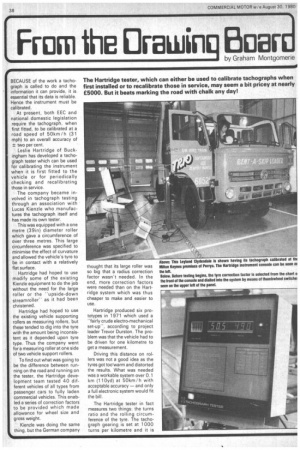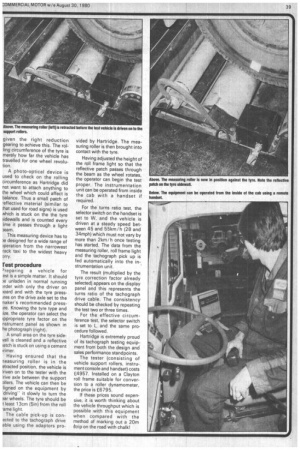( From the rowing Boar
Page 40

Page 41

If you've noticed an error in this article please click here to report it so we can fix it.
by Graham Montgomerie
BECAUSE of the work a tachograph is called to do and the ' information it can provide, it is essential that its data is reliable. Hence the instrument must be calibrated.
At present, both EEC and national domestic legislation require the tachograph, when first fitted, to be calibrated at a road speed of 50km /h (31 mph) to an overall accuracy of ± two per cent.
Leslie Hartridge of Buckingham has developed a tachograph tester which can be used for calibrating the instrument when it is first fitted to the vehicle or for periodically checking and recalibrating those in service.
The company became involved in tachograph testing through an association with Lucas Kienzle who manufactures the tachograph itself and has made its own tester.
This was equipped with a one metre (39in) diameter roller which gave a circumference of over three metres. This large circumference was specified to minimise the effect of curvature and allowed the vehicle's tyre to be in contact with a relatively flat surface.
Hartridge had hoped to use modify some of the existing Kienzle equipment to do the job without the need for the large roller or the "upside-down streamrotleras it had been christened.
Hartridge had hoped to use the existing vehicle supporting rollers as measuring rollers, but these tended to dig into the tyre with the amount being inconsistent as it depended upon tyre type. Thus the company went for a measuring roller at one side of two vehicle support rollers.
To find out what was going to be the difference between running on the road and running on the tester, the Hartridge development team tested 40 different vehicles of all types from passenger cars to fully laden commercial vehicles. This enabled a series of correction factors to be provided which made allowance for wheel size and gross weight.
Kienzle was doing the same kthing, but the German company
thought that its large roller was so big that a radius correction factor wasn't needed. In the end, more correction factors were needed than on the Hartridge system which was thus cheaper to make and easier to use.
Hartridge produced six prototypes in 1 971 which used a -fairly crude electro-mechanical set-up", according to project leader Trevor Durston. The problem was that the vehicle had to be driven for one kilometre to get a measurement.
Driving this distance on rollers was not a good idea as the tyres got too warm and distorted the results. What was needed was a workable system over 0.1 km (110yd) at 50km h with acceptable accuracy — and only a full electronic system would fit the bill.
The Hartridge tester in fact measures two things: the turns ratio and the rolling circumference of the tyre. The tachograph gearing is set at 1000 turns per kilometre and it is given the right reduction gearing to achieve this. The rolling circumference of the tyre is merely how far the vehicle has travelled for one wheel revolution.
A photo-optical device is used to check on the rolling circumference as Hartridge did not want to attach anything to the wheel which could affect is balance. Thus a small patch of -eflective material (similar to :hat used for road signs) is used Nhich is stuck on the the tyre ;idewalls and is counted every :ime it passes through a light )eam.
This measuring device has to )e designed for a wide range of )peration from the narrowest rack taxi to the widest heavy Drry,
rest procedure
Dreparing a vehicle for est is a simple matter. It should )e unladen in normal running )rder with only the driver on )oard and with the tyre pressires on the drive axle set to the naker's recommended pressire. Knowing the tyre type and ize, the operator can select the ippropriate tyre factor on the nstrument panel as shown in he photograph (right).
A small area on the tyre sidevall is cleaned and a reflective iatch is stuck on using a cement 'rimer.
Having ensured that the leasuring roller is in the etracted position, the vehicle is !riven on to the tester with the trive axle between the support pliers. The vehicle can then be ligned on the equipment by 'drivingit slowly to turn the aar wheels. The tyre should be t least 13cm (5in) from the roll .ame light.
The cable pick-up is conected to the tachograph drive able using the adaptors pro vided by Hartridge. The measuring roller is then brought into contact with the tyre.
Having adjusted the height of the roll frame light so that the reflective patch passes through the beam as the wheel rotates, the operator can begin the test proper. The instrumentation unit can be operated from inside the cab with a handset if required.
For the turns ratio test, the selector switch on the handset is set to W, and the vehicle is driven at a steady speed between 45 and 55km /h (28 and 34mph) which must not vary by more than 2km / h once testing has started. The data from the measuring roller, roll frame light and the tachograph pick up is fed automatically into the instrumentation unit.
The result (multiplied by the tyre correction factor already selected) appears on the display panel and this represents the turns ratio of the tachograph drive cable. The consistency. should be checked by repeating the test two or three times.
For the effective circumference test, the selector switch is set to L, and the same procedure followed.
Hartridge is extremely proud of its tachograph testing equipment from both the design and sales performance standpoints.
The tester (consisting of vehicle support rollers, instrument console and handset) costs £4957. Installed on a Clayton roll frame suitable for conversion to a roller dynamometer, the price is £6795.
If these prices sound expensive, it is worth thinking about the vehicle throughput which is possible with this equipment when compared with the method of marking out a 20m gtrip on the road with chalk!




























































































